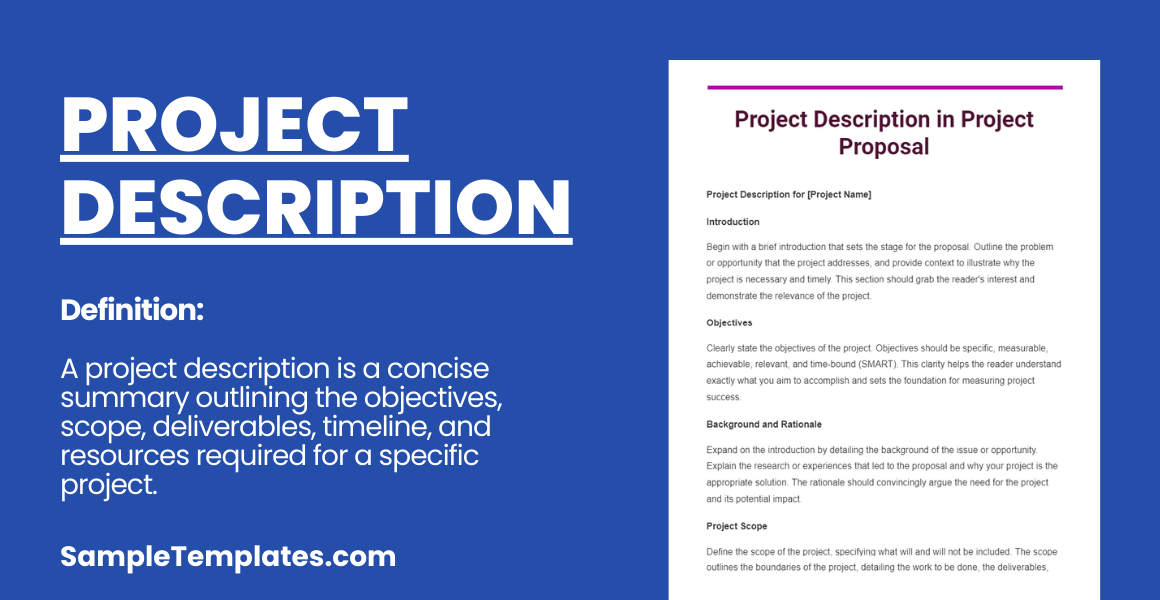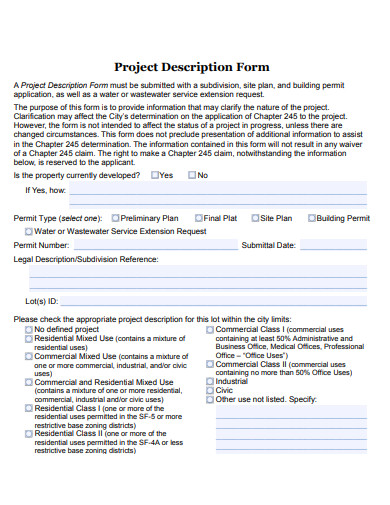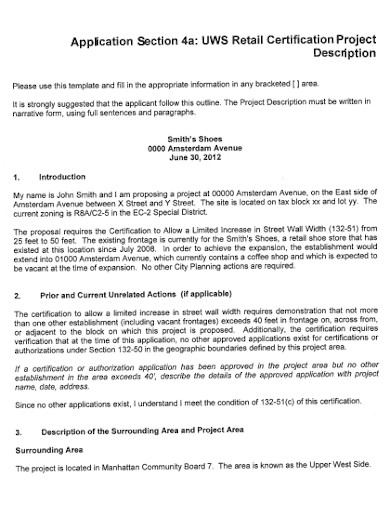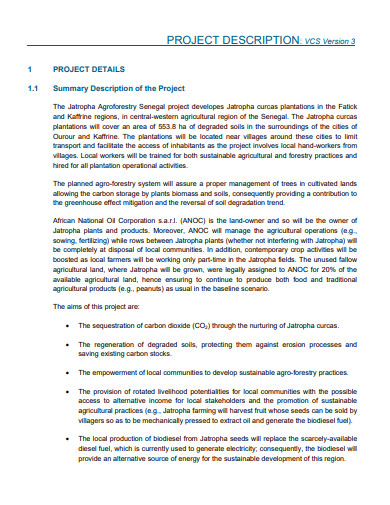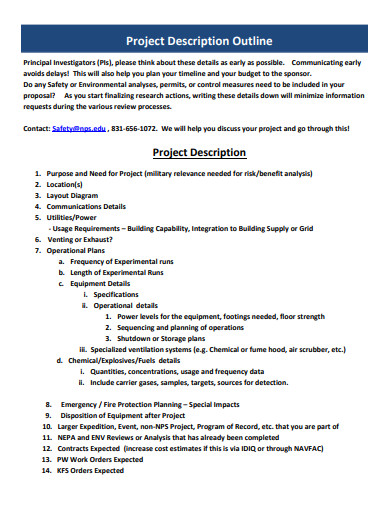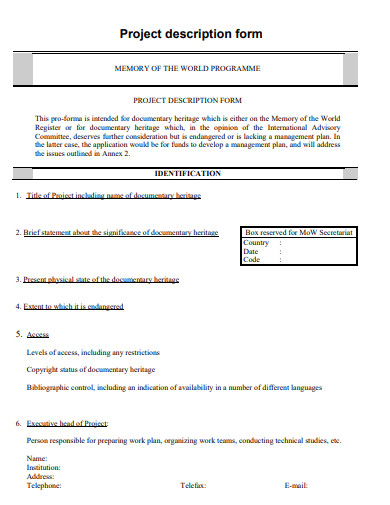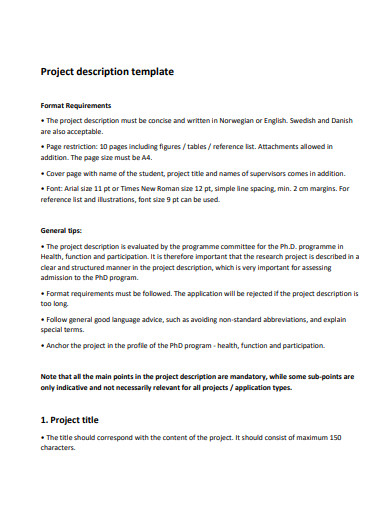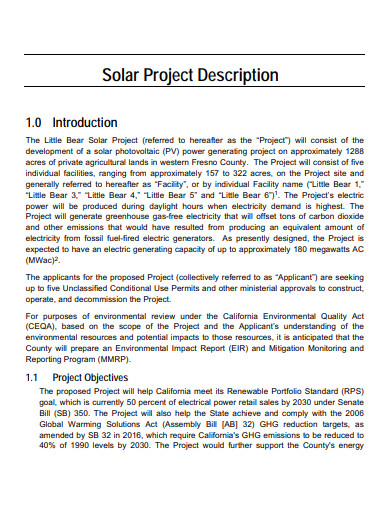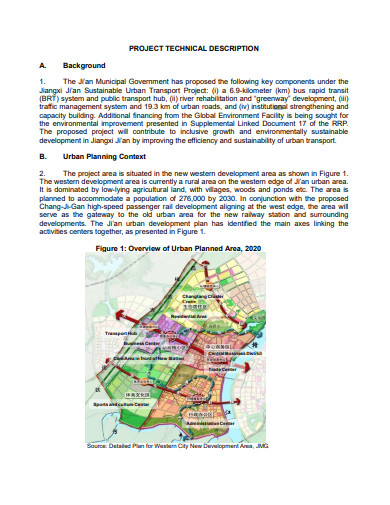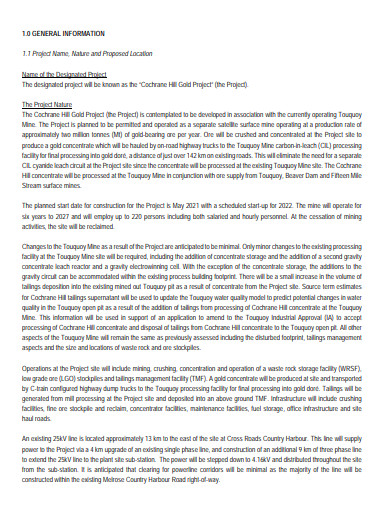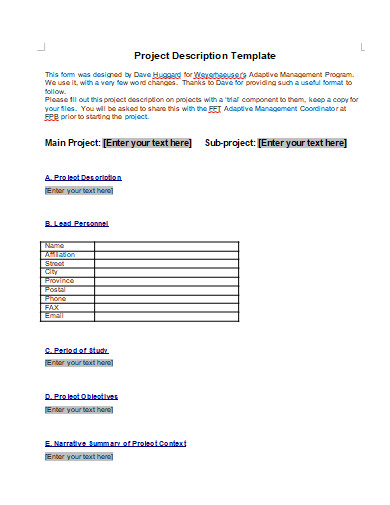Before work can begin, everyone must agree on the project’s purpose, objectives, scope of work, sponsorship, funding, and mission. A respectable Project Manager should never take a project without this knowledge. Before the project manager takes personal responsibility for its success, the project, particularly its aim, must be clearly defined. This is accomplished by a detailed project description. Need some help with this? We’ve got you covered! In this article, we provide you with free and ready-made samples of Project Descriptions in PDF and DOC format that you could use for your benefit. Keep on reading to find out more!
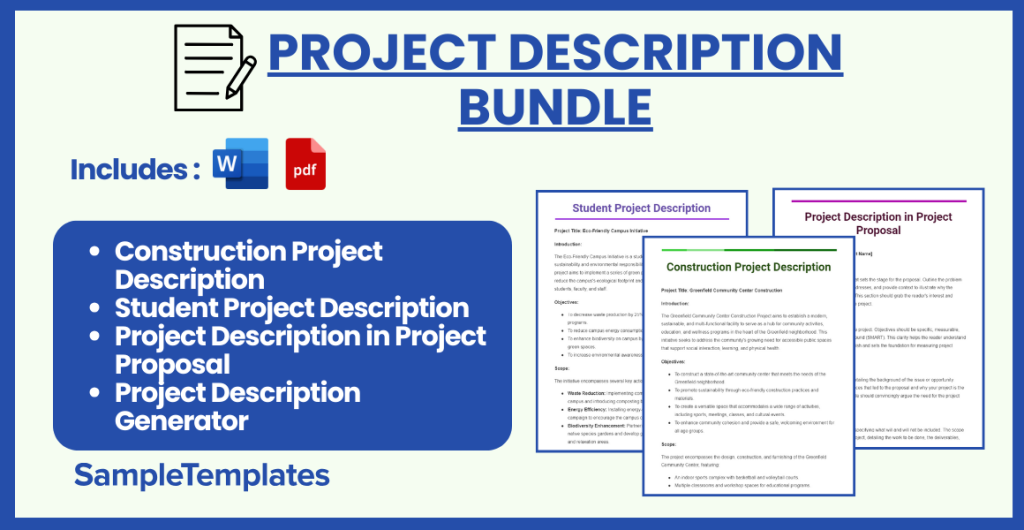
Download Project Description Bundle
Construction Project Description
Project Title: Greenfield Community Center Construction
Introduction:
The Greenfield Community Center Construction Project aims to establish a modern, sustainable, and multi-functional facility to serve as a hub for community activities, education, and wellness programs in the heart of the Greenfield neighborhood. This initiative seeks to address the community’s growing need for accessible public spaces that support social interaction, learning, and physical health.
Objectives:
- To construct a state-of-the-art community center that meets the needs of the Greenfield neighborhood.
- To promote sustainability through eco-friendly construction practices and materials.
- To create a versatile space that accommodates a wide range of activities, including sports, meetings, classes, and cultural events.
- To enhance community cohesion and provide a safe, welcoming environment for all age groups.
Scope:
The project encompasses the design, construction, and furnishing of the Greenfield Community Center, featuring:
- An indoor sports complex with basketball and volleyball courts.
- Multiple classrooms and workshop spaces for educational programs.
- A large multipurpose hall for events and gatherings.
- Outdoor recreational areas, including playgrounds and a community garden.
- Environmentally sustainable features such as solar panels, green roofs, and water recycling systems.
Methodology/Approach:
Construction will follow a phased approach, beginning with site preparation and groundwork, followed by structural development, and finishing with interior design and landscaping. The project will employ green construction techniques, prioritizing materials and methods that minimize environmental impact. Stakeholder engagement will be integral throughout the project, ensuring community needs and feedback are reflected in the final design.
Timeline:
The project is scheduled to commence in June 2024, with completion targeted for December 2025. Key milestones include site clearance by August 2024, structure completion by April 2025, and the official opening in January 2026.
Budget Overview:
The estimated budget for the Greenfield Community Center Construction is $5 million, covering land acquisition, construction costs, furnishing, and landscaping. Funding sources include local government allocations, grants, and community fundraising efforts.
Team and Roles:
The project will be led by XYZ Construction as the main contractor, with ABC Architects providing design services. The Greenfield Neighborhood Association will serve as the community liaison, ensuring ongoing communication and feedback between the project team and residents.
Risks and Mitigation Strategies:
Potential risks include construction delays due to weather, unforeseen site conditions, and budget overruns. Mitigation strategies involve thorough site analysis, contingency budgeting, and flexible project planning to accommodate adjustments as needed.
Impact and Benefits:
Upon completion, the Greenfield Community Center will provide a vibrant space for residents to engage in recreational, educational, and cultural activities. It will foster community spirit, support local programs, and promote environmental sustainability through its green building design.
Conclusion:
The Greenfield Community Center Construction Project represents a significant investment in the community’s future, promising to enhance the quality of life for residents and contribute to the sustainable development of the neighborhood.
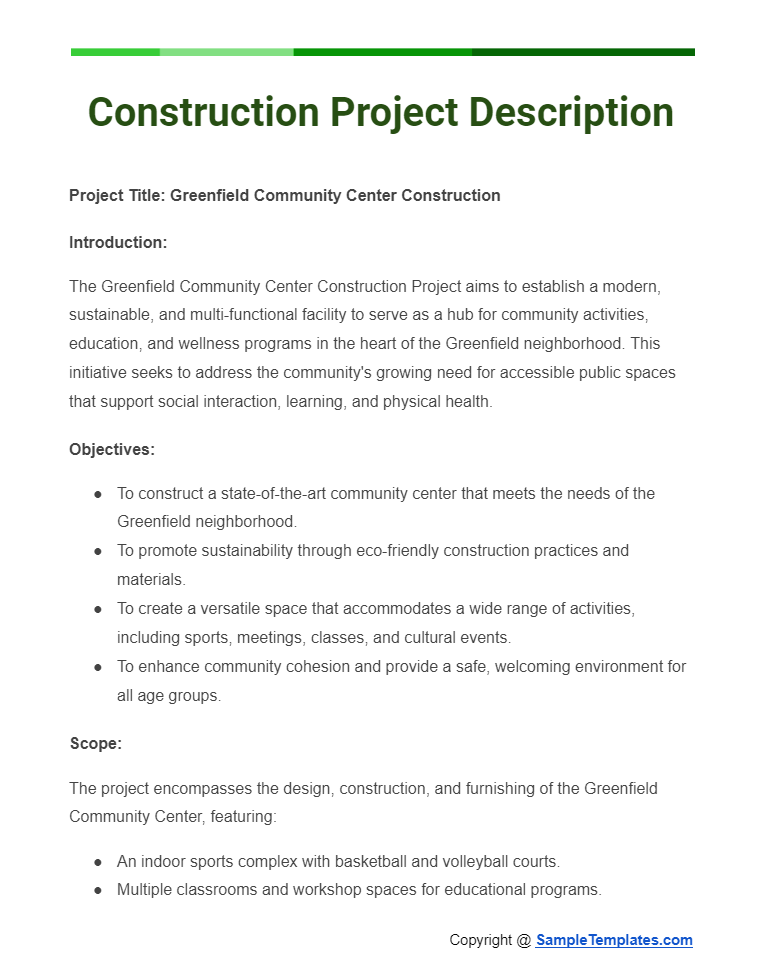
Student Project Description
Project Title: Eco-Friendly Campus Initiative
Introduction:
The Eco-Friendly Campus Initiative is a student-led project designed to promote sustainability and environmental responsibility within the university community. This project aims to implement a series of green practices and awareness campaigns to reduce the campus’s ecological footprint and foster a culture of sustainability among students, faculty, and staff.
Objectives:
- To decrease waste production by 25% through recycling and composting programs.
- To reduce campus energy consumption by 10% via energy-efficiency measures.
- To enhance biodiversity on campus by planting native gardens and creating green spaces.
- To increase environmental awareness through workshops, seminars, and events.
Scope:
The initiative encompasses several key actions, including:
- Waste Reduction: Implementing comprehensive recycling stations across campus and introducing composting bins in cafeteria areas.
- Energy Efficiency: Installing energy-saving lighting and promoting a “switch off” campaign to encourage the campus community to reduce electricity use.
- Biodiversity Enhancement: Partnering with local environmental groups to plant native species gardens and develop green spaces that serve as outdoor study and relaxation areas.
- Awareness and Education: Organizing monthly environmental workshops and an annual sustainability fair to educate the campus community on sustainable practices and environmental issues.
Methodology/Approach:
The project will be executed through collaboration with university facilities, student organizations, and local environmental groups. A phased approach will be adopted, starting with awareness campaigns, followed by the gradual implementation of recycling, energy-saving measures, and biodiversity projects. Success will be measured through waste and energy audits, participation rates in environmental programs, and feedback from the campus community.
Timeline:
- Preparation and Planning: April 2024 – May 2024
- Launch Awareness Campaign: June 2024
- Implement Recycling and Composting Programs: July 2024
- Install Energy-Efficient Lighting: August 2024
- Garden Planting and Green Space Development: September 2024 – October 2024
- Organize Monthly Workshops: Starting June 2024
- Annual Sustainability Fair: April 2025
Budget Overview:
An estimated budget of $15,000 is required to cover the costs of recycling bins, composting facilities, energy-efficient lighting, gardening supplies, and event organization. Funding will be sought from university sustainability grants, local business sponsorships, and fundraising events.
Team and Roles:
The project team consists of students from various departments, including Environmental Science, Engineering, and Business, ensuring a multidisciplinary approach. Key roles include Project Manager, Waste Management Coordinator, Energy Efficiency Coordinator, Biodiversity Officer, and Events and Workshops Organizer.
Risks and Mitigation Strategies:
Potential risks include insufficient funding, low participation rates, and challenges in maintaining long-term engagement. Mitigation strategies involve securing initial funding through grants and sponsorships, engaging the campus community through targeted marketing and incentives, and establishing a sustainability club to ensure ongoing project involvement and leadership.
Impact and Benefits:
The Eco-Friendly Campus Initiative aims to make tangible improvements in campus sustainability, reduce environmental impact, and increase ecological awareness. By embedding sustainable practices into campus life, the project seeks to inspire positive environmental action among students, faculty, and the broader community.
Conclusion:
The Eco-Friendly Campus Initiative represents a comprehensive effort to promote sustainability on campus. Through practical measures and community engagement, it aims to create a greener, more environmentally conscious university environment for current and future generations.

Project Description in Project Proposal
Project Description for [Project Name]
Introduction
Begin with a brief introduction that sets the stage for the proposal. Outline the problem or opportunity that the project addresses, and provide context to illustrate why the project is necessary and timely. This section should grab the reader’s interest and demonstrate the relevance of the project.
Objectives
Clearly state the objectives of the project. Objectives should be specific, measurable, achievable, relevant, and time-bound (SMART). This clarity helps the reader understand exactly what you aim to accomplish and sets the foundation for measuring project success.
Background and Rationale
Expand on the introduction by detailing the background of the issue or opportunity. Explain the research or experiences that led to the proposal and why your project is the appropriate solution. The rationale should convincingly argue the need for the project and its potential impact.
Project Scope
Define the scope of the project, specifying what will and will not be included. The scope outlines the boundaries of the project, detailing the work to be done, the deliverables, and the features or functions that will be developed. It helps manage stakeholders’ expectations and prevent scope creep.
Methodology/Approach
Describe the methods or approach you will use to achieve the project objectives. This could involve phases, strategies, techniques, and processes that will be applied throughout the project. This section should demonstrate your knowledge of the subject and your plan for executing the project effectively.
Timeline
Provide an estimated timeline for the project, including the start and end dates, key milestones, and major deliverables. A well-structured timeline shows the project’s feasibility and your understanding of what it takes to complete the project successfully.
Budget
Outline the projected budget, including a breakdown of costs for materials, resources, labor, and any other expenses. Be transparent and realistic with your estimates to build trust and demonstrate effective project planning.
Team and Roles
Introduce the project team, highlighting their expertise, roles, and responsibilities within the project. This showcases the human resources available for the project and their capability to deliver the expected outcomes.
Expected Outcomes and Impact
Describe what success looks like for the project, detailing the expected outcomes and the impact it will have on the problem or opportunity addressed. This section ties back to the objectives and demonstrates the value and benefits of the project.
Risk Management
Identify potential risks to the project’s success and outline strategies for mitigating these risks. Showing that you have considered possible challenges and prepared solutions enhances the credibility of your proposal.
Conclusion
Conclude the project description by summarizing the key points and reiterating the importance and feasibility of the project. This final note should leave the reader with a strong impression of the project’s significance and your commitment to its success.
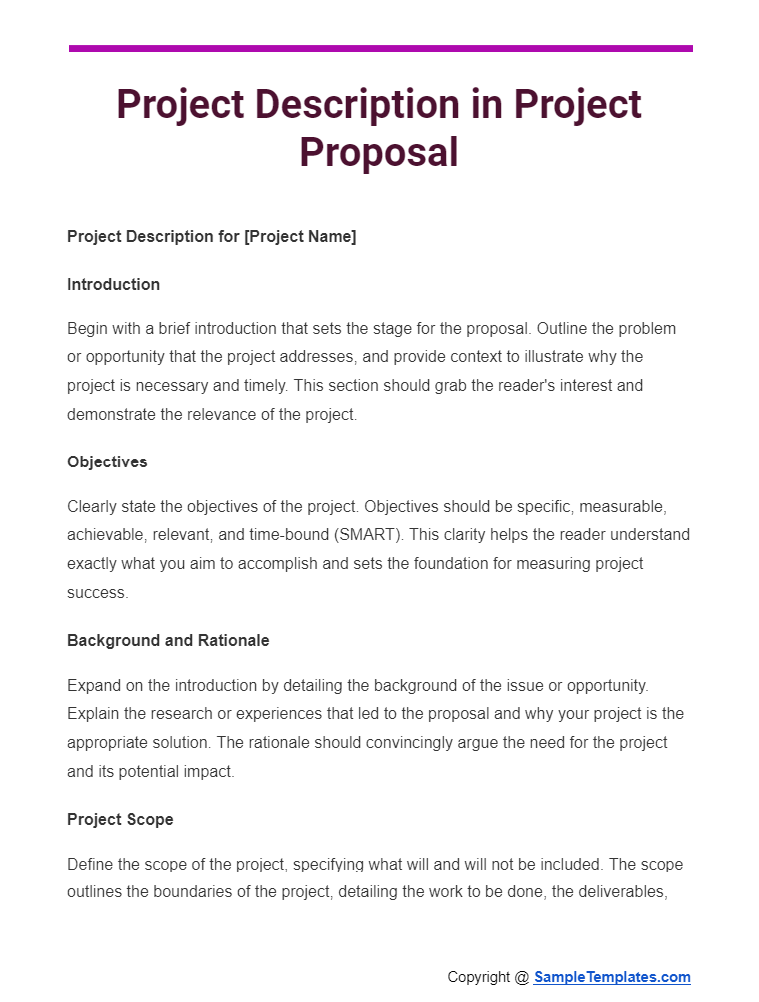
Project Description Generator
Project Title:
Urban Green Space Revitalization Initiative
Introduction/Background:
The Urban Green Space Revitalization Initiative is designed to address the increasing need for accessible and healthy recreational spaces in Downtown Metropolis. Recent studies have shown a significant decline in urban green areas, contributing to lower air quality and reduced quality of life for city residents. This project aims to rejuvenate neglected urban spaces, transforming them into vibrant, green, community-focused areas.
Objectives:
- To transform three neglected urban areas into green spaces within two years.
- To improve local air quality and provide new recreational opportunities for the community.
- To foster community engagement and awareness regarding environmental conservation.
Scope:
The project will focus on the planning, design, and implementation of green spaces in specified neglected urban areas, including:
- The installation of native plants and trees.
- The creation of walkways and seating areas.
- Development of community gardens. Excluded from the scope are commercial developments and non-recreational infrastructure.
Methodology/Approach:
The approach will involve community consultation to ensure the green spaces meet local needs, followed by the engagement of landscape architects to design environmentally sustainable and accessible areas. The project will utilize eco-friendly materials and native plant species to promote biodiversity.
Timeline:
- Community Consultation: May 2024 – July 2024
- Design Phase: August 2024 – December 2024
- Implementation: January 2025 – September 2025
- Opening Ceremony: October 2025
Budget Overview:
The estimated budget for the Urban Green Space Revitalization Initiative is $500,000, covering design, materials, labor, and maintenance planning. Funding sources include city grants, environmental non-profits, and community fundraising.
Team and Roles:
- Project Manager: Alex Rivera – Oversees the entire project, ensuring timelines and budget are adhered to.
- Landscape Architect: Jamie Chen – Designs the green spaces, selecting appropriate plants and layout.
- Community Liaison: Sara Jenkins – Engages with the community to gather input and feedback.
Risks and Mitigation Strategies:
- Risk: Delay due to unforeseen environmental factors.
- Mitigation: Develop a flexible project timeline with buffer periods.
- Risk: Insufficient funding.
- Mitigation: Establish a contingency fund and explore additional funding sources.
Impact and Benefits:
The revitalization of urban areas into green spaces will significantly enhance local air quality, provide serene recreational areas for residents, and promote community engagement in environmental conservation. Long-term benefits include increased biodiversity and the promotion of sustainable urban living practices.
Evaluation and Monitoring:
Success will be evaluated through community feedback, increased biodiversity metrics, and usage rates of the new green spaces. Regular monitoring will be conducted to assess the health of the plant life and infrastructure integrity.
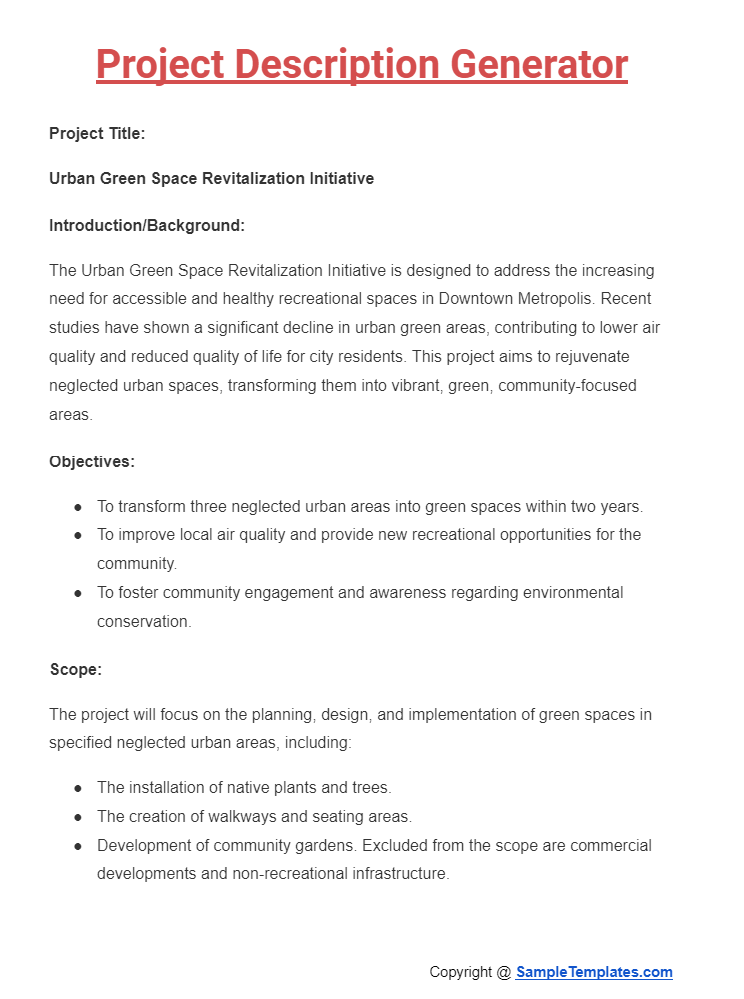
Browse More Templates On Project Description
Elements of a Good Project Description
A good project description is a critical component of project documentation, providing a clear overview of what the project entails, its objectives, and how it plans to achieve them. Here are the key elements that should be included to ensure a comprehensive and effective project description:
1. Project Title
- A concise, descriptive title that gives an immediate understanding of what the project is about.
2. Introduction/Background
- A brief overview of the project context and background, explaining the need or problem the project aims to address.
3. Objectives
- Clearly defined goals and objectives of the project, outlining what it intends to accomplish. Objectives should be specific, measurable, achievable, relevant, and time-bound (SMART).
4. Scope
- A detailed description of the project’s scope, including what will be done, the deliverables, and the boundaries of the project (what is and isn’t included).
5. Methodology/Approach
- An explanation of the methods or approaches to be used to achieve the project’s objectives, including any specific models, frameworks, or technologies that will be applied.
6. Timeline
- A projected timeline for the project, including key milestones, phases, and deadlines. This may be presented as a Gantt chart or a simple list of dates and activities.
7. Budget
- An outline of the project budget, detailing the estimated costs associated with each component of the project. This should include both direct and indirect costs.
8. Team and Roles
- Information on the project team, including the roles and responsibilities of each member, to clarify who is involved and their contribution to the project.
9. Risks and Challenges
- An assessment of potential risks and challenges that could impact the project, along with strategies for mitigating these risks.
10. Impact and Benefits
- A description of the expected impact and benefits of the project, both during its implementation and after its completion. This should relate back to the objectives and highlight the value the project brings.
11. Evaluation and Monitoring
- Details on how the project’s progress and success will be evaluated and monitored, including the criteria for success and the tools or methods that will be used for project evaluation.
12. Sustainability or Follow-up Plans
- If applicable, outline any plans for sustaining the project’s outcomes or impact beyond its immediate completion, including any follow-up projects or maintenance activities.
Incorporating these elements into a project description ensures that all stakeholders have a clear understanding of the project, its goals, and how it plans to achieve them, laying a solid foundation for successful project management and execution.
How to Write a Project Description
Writing an effective project description is essential for communicating the objectives, scope, and significance of your project to stakeholders. Here’s a step-by-step guide on how to craft a clear and comprehensive project description:
1. Start with a Clear Project Title
Begin with a concise and descriptive title that accurately reflects the essence of your project. The title should give a quick insight into what the project is about.
2. Provide an Introduction or Background
Offer context by describing the background and rationale behind the project. Explain the problem, need, or opportunity that the project aims to address. This section sets the stage for understanding the project’s relevance and necessity.
3. Define the Project Objectives
List the specific objectives you aim to achieve with the project. Objectives should be SMART: Specific, Measurable, Achievable, Relevant, and Time-bound. This clarity helps stakeholders understand what you intend to accomplish.
4. Outline the Project Scope
Detail the scope of the project, including the key deliverables and outcomes you expect. Clearly delineate what is included in the project and, importantly, what is not. This helps manage expectations and prevent scope creep.
5. Describe the Methodology or Approach
Explain how you plan to achieve the project objectives. This could include the strategies, techniques, or processes you will employ. If applicable, mention any specific technologies, tools, or frameworks that will be utilized.
6. Provide a Timeline
Include an estimated timeline for the project, highlighting key milestones and phases. This gives stakeholders a clear idea of the project’s duration and critical dates.
7. Detail the Budget
Outline the budget, providing a breakdown of the estimated costs associated with different aspects of the project. Transparency about funding requirements helps in securing approval and financial support.
8. List the Project Team and Roles
Identify the team members involved and their respective roles and responsibilities. This establishes accountability and clarifies who is in charge of what.
9. Identify Risks and Challenges
Acknowledge potential risks and challenges that could impact the project, along with your strategies for mitigating them. This demonstrates foresight and preparedness.
10. Highlight the Impact and Benefits
Discuss the expected impact and benefits of the project. Relate these back to the initial problem or need you outlined, showing how the project will make a difference.
11. Describe the Evaluation and Monitoring Plan
Explain how you will evaluate the project’s success and monitor its progress. Include the key performance indicators (KPIs) or criteria you will use to measure outcomes.
12. Mention Sustainability or Follow-up Plans
If relevant, discuss how the project’s results will be sustained after completion or if there are any follow-up actions planned.
Finalizing Your Project Description
- Review and Edit: Once drafted, review your project description for clarity, coherence, and completeness. Ensure it is free from jargon and easily understandable by all stakeholders.
- Seek Feedback: It can be helpful to get feedback from colleagues or other stakeholders to ensure that the description is clear and comprehensive.
By following these steps, you can write a project description that effectively communicates the value and structure of your project, setting a strong foundation for its success.
Project Description Template
Project Description Form Template
Retail Certification Project Description Template
Tips For Writing Project Description
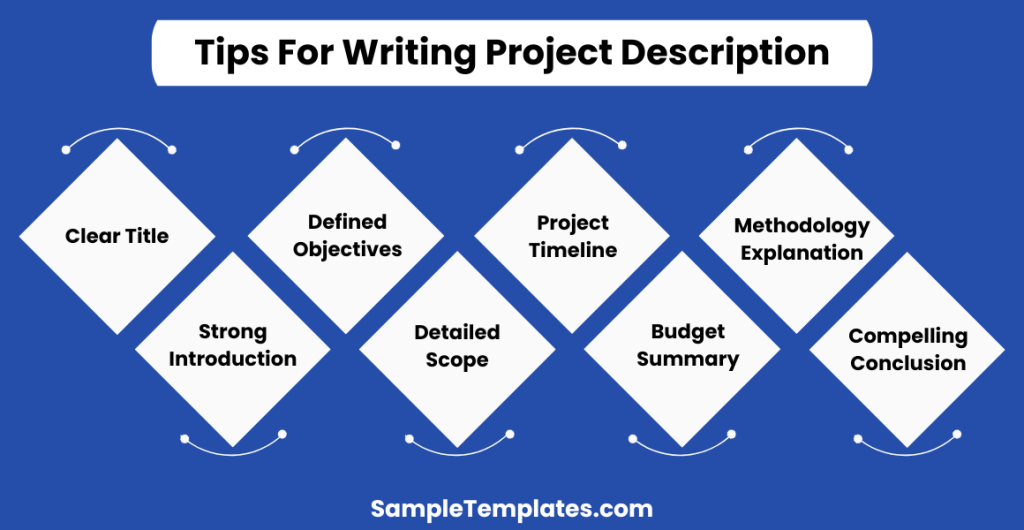
Writing an effective project description is crucial for communicating the essence and objectives of your project to stakeholders, potential funders, or team members. Here are tips to help you craft a compelling project description:
1. Start with a Clear Title
- Begin with a concise and descriptive title that gives an immediate understanding of the project’s focus and scope.
2. Provide a Strong Introduction
- Open with a brief introduction that sets the context for the project. Explain the background, the problem or need the project addresses, and its relevance.
3. Define the Objectives Clearly
- Clearly articulate the objectives of the project. Use specific, measurable, achievable, relevant, and time-bound (SMART) criteria to outline what the project aims to accomplish.
4. Detail the Scope
- Describe what the project will and will not cover. A well-defined scope helps manage expectations and sets clear boundaries for the project’s deliverables.
5. Explain Your Methodology
- Outline the methods, strategies, or technologies you will use to achieve the project objectives. This shows the feasibility of your project and your approach to tackling the project’s challenges.
6. Outline the Project Timeline
- Provide a realistic timeline that includes key milestones and phases. This helps stakeholders understand the project’s duration and significant deadlines.
7. Include a Budget Summary
- Offer an overview of the project budget, highlighting major expenses. This transparency builds trust and shows you’ve thought through the financial aspects of the project.
8. Describe the Team and Roles
- Introduce the project team and outline each member’s roles and responsibilities. Demonstrating that you have a capable team in place can be reassuring to stakeholders.
9. Identify Risks and Mitigation Strategies
- Acknowledge potential risks to the project and how you plan to address them. This shows foresight and preparedness to handle challenges.
10. Highlight the Project’s Impact
- Explain the expected outcomes, benefits, and impact of the project. Connect these back to the initial problem or need to illustrate the project’s value.
11. Discuss Evaluation and Monitoring Plans
- Detail how you will measure the project’s success and monitor progress. This can include specific metrics, evaluation methods, or performance indicators.
12. Consider Sustainability or Future Steps
- If applicable, describe how the project’s outcomes will be sustained after completion, or mention any follow-up projects.
13. Keep It Clear and Concise
- Use clear, straightforward language and avoid jargon that might confuse readers. Keep the description concise but comprehensive enough to cover all critical aspects of the project.
14. Review and Revise
- After drafting your project description, review it for clarity, accuracy, and completeness. Consider getting feedback from a colleague or stakeholder to ensure it effectively communicates your project’s essence.
By following these tips, you can create a project description that effectively conveys the importance, objectives, and planned execution of your project, engaging and informing all relevant stakeholders.
Sample Project Description
Project Description Outline Template
Sample Project Description Form Template
Simple Project Description Template
Solar Project Description Template
Common Mistakes to Avoid When Writing Project Descriptions
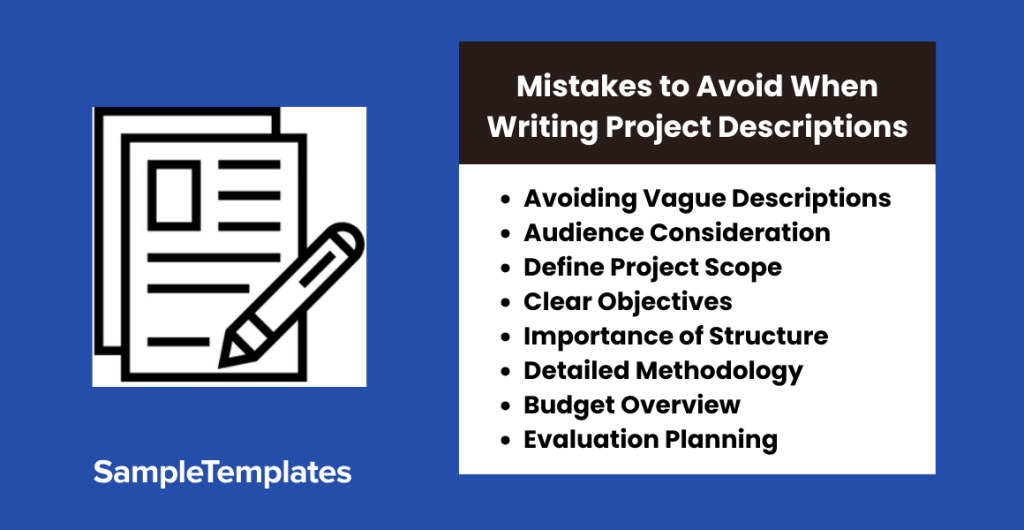
When crafting project descriptions, certain pitfalls can detract from the clarity and effectiveness of your narrative. Here are common mistakes to avoid to ensure your project description is compelling and comprehensive:
1. Being Vague or Overly General
- Avoid vague descriptions that don’t clearly explain the project’s objectives, scope, and impact. Specific details help readers understand the project’s purpose and how it will be executed.
2. Ignoring the Audience
- Failing to consider the knowledge level and interests of your audience can lead to confusion or disinterest. Tailor the language and details to fit the audience, whether they are experts in the field, potential funders, or the general public.
3. Omitting the Project Scope
- Neglecting to define the project scope can lead to misunderstandings about the project’s deliverables and boundaries. Be clear about what the project will and will not cover.
4. Lacking Clear Objectives
- Without clear, measurable objectives, it’s difficult for readers to understand what the project aims to achieve. Ensure your goals are specific, measurable, achievable, relevant, and time-bound (SMART).
5. Overlooking the Importance of Structure
- A disorganized project description can make it hard to follow and understand the key points. Use headings, bullet points, and short paragraphs to structure the information clearly.
6. Insufficient Detail on Methodology
- A lack of detail on how the project will be carried out leaves readers questioning its feasibility. Explain the methods, strategies, and technologies that will be used.
7. Skipping the Budget Overview
- Not including a budget overview can raise questions about the project’s financial planning and feasibility. Provide a summary of the budget to show that the financial aspects have been thoroughly considered.
8. Underestimating Risks and Mitigation Strategies
- Ignoring potential risks or not offering mitigation strategies can make a project seem unrealistic or poorly planned. Identify key risks and how they will be addressed.
9. Failing to Highlight the Impact
- Not articulating the project’s expected impact or benefits can make it seem inconsequential. Describe how the project will make a difference in addressing the problem or need.
10. Neglecting the Evaluation Plan
- Omitting how the project’s success will be measured and monitored can undermine its credibility. Outline the criteria for success and the methods for evaluation and monitoring.
11. Using Jargon or Technical Language Unnecessarily
- Overuse of jargon or technical terms can alienate readers unfamiliar with the terminology. Use clear, accessible language and explain any necessary technical terms.
12. Forgetting to Proofread
- Typos, grammatical errors, and unclear sentences can detract from the professionalism and credibility of the project description. Always proofread the document or have it reviewed by others.
By avoiding these common mistakes, you can create a project description that effectively communicates your project’s vision, purpose, and plan to your intended audience.
Project Technical Description Template
Project Description Summary Template
Printable Project Description Template
What Is a Project Description?
A project description is a high-level explanation of why you’re working on it. The paper defines the goals and fundamental characteristics of a project. Consider it an elevator pitch that focuses on what and why rather than how. A project description is often written early in the project management lifecycle, at the project beginning phase. The project description is frequently written by the project manager. You may need to learn how to create a project description in a project proposal if you work for an organization that seeks grant money or are drafting a research proposal.
How to Make a Project Description
A well-written project description allows the targeted audience to grasp the concept and context of the proposed project work and decide whether or not to approve and fund it. A Project Description Template can help provide you with the framework you need to ensure that you have a well-prepared and robust description on hand. To do so, you can choose one of our excellent templates listed above. If you want to write it yourself, follow these steps below to guide you:
1. Provide a summary.
Write a one- or two-paragraph description of the project’s objectives. Avoid going into too much detail about your history or previous work schedule. Not only can a strong project overview serve as your elevator pitch, but it will also help you clarify wider difficulties with your strategy.
2. Define the scope and include your objectives.
Framing the project entails stating the goal and the problem to be solved. The key intent for project beginning is written under the purpose. Explain the issue or opportunity and how the initiative will solve it. Identify SMART project objectives as well. You must identify the business forces that drive project transformation and analyze how the project affects the organization’s performance evaluation.
3. Analyze the cost-benefit ratio.
Evaluating entails determining the advantages that will accrue if the project is completed successfully. You must describe the ratio between the benefits to be acquired and the cost to be covered using the findings of a cost-benefit analysis.
4. Make a timetable for the project.
Scheduling entails making a rough estimate of how long the job will take. You’ll need to create a sample timeline that illustrates the entire number of hours you’ll need to work. The timeline will be used to build the project schedule and estimate activity durations later in the planning process.
FAQ
What should the project description include?
The problem the project will address, a set of goals for the project, the general objectives for the project, and a project plan that outlines the actions the members will conduct are all included in the project descriptions.
What is a project proposal and how do you write one?
The purpose, aims, precise objectives, technique, and expected impact of the project should all be included.
What is a project proposal’s principal goal?
A project proposal’s objective is to outline a possible service provider’s offerings and outcomes so that decision-makers may evaluate vendors and choose the best one for their needs.
[/ns_row]
How do you write a project title and description?
To write a project title and description, start with a clear, concise title summarizing the project’s purpose. Follow with a brief description outlining objectives, methodology, deliverables, timeline, and stakeholders for clarity and understanding.
[/ns_row]
What is the simple description of project management?
Project management involves planning, organizing, and overseeing tasks to achieve specific goals within constraints like time, budget, and resources, ensuring successful completion.
[/ns_row]
What is a project description in a project scope statement?
A project description in a project scope statement provides a detailed overview of the project’s objectives, deliverables, timeline, resources, and stakeholders, serving as a blueprint for project execution.
A good project description gives stakeholders a road map and communicates the big picture without getting mired down in specifics. To help you get started, download our easily customizable and comprehensive templates of Project Descriptions today!
Related Posts
FREE 9+ Sample Program Coordinator Job Description Templates ...
FREE 8+ Engineer Manager Job Description Samples in PDF
FREE 11+ Construction Superintendent Job Description Samples in ...
FREE 11+ Sample Construction Project Manager Job Description ...
FREE 8+ Master Scheduler Job Description Samples in MS Word ...
FREE 10+ Monthly Project Status Report Samples in PDF
FREE 10+ Logistics Manager Job Description Samples in MS Word ...
FREE 9+ Sample Manager Job Description Templates in PDF MS ...
FREE 9+ Sample Coordinator Job Description Templates in PDF ...
FREE 11+ Scheduler Job Description Samples in MS Word PDF
FREE 8+ Sample Project Coordinator Job Description Templates in ...
FREE 9+ Field Engineer Job Description Samples in PDF
FREE 6+ Media Planner Job Description Samples in MS Word PDF
FREE 12+ Management Job Description Samples in MS Word PDF
FREE 10+ Digital Marketing Report Samples [ Project, Industry ...
